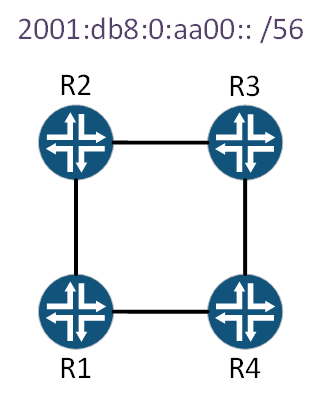Lab Topology
In this topology, there are four routers connected in a square shape. Each router has two loopback interfaces.
The 2001:db8:0:aa00::/56 network is available for you to allocate as you see fit.

Lab Files
See general lab information to get started.
Challenge – Scenario
No config has been pre-applied to this lab (other than hostnames).
You need to:
- Configure /127 links between each of the routers
- Configure two loopback interfaces on each router, with /64 networks
- Configure OSPFv3 on the four routers
- Make the loopback interfaces passive
Challenge – Solution
/127 Links
Let’s start by allocating these networks to the routers:
- R1/R2 – 2001:db8:0:aa00::0 /127
- R2/R3 – 2001:db8:0:aa00::2 /127
- R3/R4 – 2001:db8:0:aa00::4 /127
- R4/R1 – 2001:db8:0:aa00::6 /127
R1(config)#int gi0/0 R1(config-if)#desc Link to R2 R1(config-if)#ipv6 address 2001:db8:0:aa00::1/127 R1(config-if)#no shut R1(config)#int gi0/1 R1(config-if)#desc Link to R4 R1(config-if)#ipv6 address 2001:db8:0:aa00::7/127 R1(config-if)#no shut
R2(config)#int gi0/0 R2(config-if)#desc Link to R1 R2(config-if)#ipv6 address 2001:db8:0:aa00::0/127 R2(config-if)#no shut R2(config)#int gi0/1 R2(config-if)#desc Link to R3 R2(config-if)#ipv6 address 2001:db8:0:aa00::2/127 R2(config-if)#no shut
R3(config)#int gi0/0 R3(config-if)#desc Link to R4 R3(config-if)#ipv6 address 2001:db8:0:aa00::5/127 R3(config-if)#no shut R3(config)#int gi0/1 R3(config-if)#desc Link to R2 R3(config-if)#ipv6 address 2001:db8:0:aa00::3/127 R3(config-if)#no shut
R4(config)#int gi0/0 R4(config-if)#desc Link to R3 R4(config-if)#ipv6 address 2001:db8:0:aa00::4/127 R4(config-if)#no shut R4(config)#int gi0/1 R4(config-if)#desc Link to R1 R4(config-if)#ipv6 address 2001:db8:0:aa00::6/127 R4(config-if)#no shut
Loopback Interfaces
We should now allocate /64’s for each loopback interface:
- R1, lo1 – 2001:db8:0:aa11:: /64
- R1, lo2 – 2001:db8:0:aa12:: /64
- R2, lo1 – 2001:db8:0:aa21:: /64
- R2, lo2 – 2001:db8:0:aa22:: /64
- R3, lo1 – 2001:db8:0:aa31:: /64
- R3, lo2 – 2001:db8:0:aa32:: /64
- R4, lo1 – 2001:db8:0:aa41:: /64
- R4, lo2 – 2001:db8:0:aa42:: /64
R1(config)#int lo1
R1(config-if)#ipv6 address 2001:db8:0:aa11::1/64
R1(config)#int lo2
R1(config-if)#ipv6 address 2001:db8:0:aa12::1/64
R2(config)#int lo1 R2(config-if)#ipv6 address 2001:db8:0:aa21::1/64 R2(config)#int lo2 R2(config-if)#ipv6 address 2001:db8:0:aa22::1/64
R3(config)#int lo1 R3(config-if)#ipv6 address 2001:db8:0:aa31::1/64 R3(config)#int lo2 R3(config-if)#ipv6 address 2001:db8:0:aa32::1/64
R4(config)#int lo1
R4(config-if)#ipv6 address 2001:db8:0:aa41::1/64
R4(config)#int lo2
R4(config-if)#ipv6 address 2001:db8:0:aa42::1/64
OSPFv3
To configure OSPFv3, we start by enabling the process. This is the same on all routers. While we’re doing that, we can also set the reference bandwidth, as well as enabling passive interfaces by default (with gi0/0 and gi0/1 as non-passive).
R1(config)#ipv6 unicast-routing R1(config)#router ospfv3 10 R1(config-router)#auto-cost reference-bandwidth 1000000 R1(config-router)#passive-interface default R1(config-router)#no passive-interface gi0/0 R1(config-router)#no passive-interface gi0/1
We should also set a router-ID as a matter of best practice:
R1(config-router)#router-id 1.1.1.1 R2(config-router)#router-id 2.2.2.2 R3(config-router)#router-id 3.3.3.3 R4(config-router)#router-id 4.4.4.4
Now to enable OSPF on interfaces. This can be repeated on all routers:
R1(config)#int gi0/0
R1(config-if)#ipv6 ospf 10 area 0
% OSPFv3-10-IPv6: Reference bandwidth is changed.
Please ensure reference bandwidth is consistent across all routers.
R1(config)#int gi0/1
R1(config-if)#ipv6 ospf 10 area 0
R1(config)#int lo1
R1(config-if)#ipv6 ospf 10 area 0
R1(config)#int lo2
R1(config-if)#ipv6 ospf 10 area 0
One way to confirm this is working is to look at neighbours:
R1#show ospf neighbor
OSPFv3 10 address-family ipv6 (router-id 1.1.1.1)
Neighbor ID Pri State Dead Time Interface ID Interface
4.4.4.4 1 FULL/BDR 00:00:33 3 GigabitEthernet0/1
2.2.2.2 1 FULL/BDR 00:00:39 2 GigabitEthernet0/0
The other way is to look at the routing table, and confirm all routes are there:
R1#show ipv6 route
IPv6 Routing Table - default - 16 entries
C 2001:DB8:0:AA00::/127 [0/0]
via GigabitEthernet0/0, directly connected
L 2001:DB8:0:AA00::1/128 [0/0]
via GigabitEthernet0/0, receive
O 2001:DB8:0:AA00::2/127 [110/2000]
via FE80::5054:FF:FE03:687E, GigabitEthernet0/0
O 2001:DB8:0:AA00::4/127 [110/2000]
via FE80::5054:FF:FE02:6B4C, GigabitEthernet0/1
C 2001:DB8:0:AA00::6/127 [0/0]
via GigabitEthernet0/1, directly connected
L 2001:DB8:0:AA00::7/128 [0/0]
via GigabitEthernet0/1, receive
C 2001:DB8:0:AA11::/64 [0/0]
via Loopback1, directly connected
L 2001:DB8:0:AA11::1/128 [0/0]
via Loopback1, receive
C 2001:DB8:0:AA12::/64 [0/0]
via Loopback2, directly connected
L 2001:DB8:0:AA12::1/128 [0/0]
via Loopback2, receive
O 2001:DB8:0:AA21::1/128 [110/1000]
via FE80::5054:FF:FE03:687E, GigabitEthernet0/0
O 2001:DB8:0:AA22::1/128 [110/1000]
via FE80::5054:FF:FE03:687E, GigabitEthernet0/0
O 2001:DB8:0:AA31::1/128 [110/2000]
via FE80::5054:FF:FE03:687E, GigabitEthernet0/0
via FE80::5054:FF:FE02:6B4C, GigabitEthernet0/1
O 2001:DB8:0:AA32::1/128 [110/2000]
via FE80::5054:FF:FE03:687E, GigabitEthernet0/0
via FE80::5054:FF:FE02:6B4C, GigabitEthernet0/1
O 2001:DB8:0:AA41::1/128 [110/1000]
via FE80::5054:FF:FE02:6B4C, GigabitEthernet0/1
L FF00::/8 [0/0]
via Null0, receive